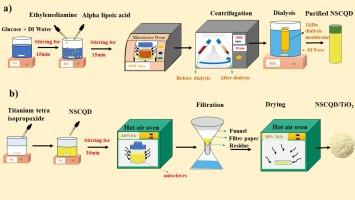Nitrogen, sulphur co-doped carbon quantum dots scaffolded on TiO2 nanoparticles towards efficient photocatalysts for hydrogen evolution
IF 5.9
3区 工程技术
Q1 CHEMISTRY, MULTIDISCIPLINARY
Journal of Industrial and Engineering Chemistry
Pub Date : 2025-04-29
DOI:10.1016/j.jiec.2025.04.042
引用次数: 0
Abstract
The solar-to-hydrogen conversion photocatalysts based on carbon quantum dots based nanomaterials have demonstrated significant promise in the realm of renewable energy. Here in, we reported a facile synthesis of nitrogen Sulphur co-doped carbon dots decorated TiO2 nanoparticles (NSCT) as robust and efficient photocatalyst for visible light driven photocatalytic hydrogen production, and also its photocatalytic H2 production activity has been related with nitrogen doped carbon quantum dots decorated TiO2 nanoparticles (NCT), sulphur doped carbon quantum dots decorated TiO2 nanoparticles (PCT), carbon quantum dots decorated TiO2 nanoparticles (CT), NSCQDS and TiO2 nanoparticles. The developed NSCT nanocomposite showed 11 times higher generation of hydrogen as compared with bare TiO2 nanostructures. The enhanced hydrogen production activity of NSCT nanocomposite is due to its improved absorption capacity in the visible region and due to suppression in the decay life time of photogenerated electrons as well as reduction in the work function(WF) of NSCT nanocomposites compared to other nanocomposites.

氮、硫共掺杂碳量子点在TiO2纳米颗粒上的支架结构,作为高效析氢光催化剂
基于碳量子点纳米材料的太阳能-氢转换光催化剂在可再生能源领域具有重要的应用前景。本文报道了氮硫共掺杂碳点修饰TiO2纳米粒子(NSCT)作为可见光催化制氢的强大高效光催化剂的简单合成,并且其光催化制氢活性与氮掺杂碳量子点修饰TiO2纳米粒子(NCT)、硫掺杂碳量子点修饰TiO2纳米粒子(PCT)、碳量子点修饰TiO2纳米粒子(CT)、氮掺杂碳量子点修饰TiO2纳米粒子(NCT)、硫掺杂碳量子点修饰TiO2纳米粒子(PCT)、NSCQDS和TiO2纳米颗粒。该NSCT纳米复合材料的产氢量是裸TiO2纳米结构的11倍。与其他纳米复合材料相比,NSCT纳米复合材料的产氢活性增强是由于其在可见光区吸收能力的提高,以及光生电子衰变寿命的抑制以及功函数(WF)的降低。
本文章由计算机程序翻译,如有差异,请以英文原文为准。
求助全文
约1分钟内获得全文
求助全文
来源期刊
CiteScore
10.40
自引率
6.60%
发文量
639
审稿时长
29 days
期刊介绍:
Journal of Industrial and Engineering Chemistry is published monthly in English by the Korean Society of Industrial and Engineering Chemistry. JIEC brings together multidisciplinary interests in one journal and is to disseminate information on all aspects of research and development in industrial and engineering chemistry. Contributions in the form of research articles, short communications, notes and reviews are considered for publication. The editors welcome original contributions that have not been and are not to be published elsewhere. Instruction to authors and a manuscript submissions form are printed at the end of each issue. Bulk reprints of individual articles can be ordered. This publication is partially supported by Korea Research Foundation and the Korean Federation of Science and Technology Societies.

 求助内容:
求助内容: 应助结果提醒方式:
应助结果提醒方式:


